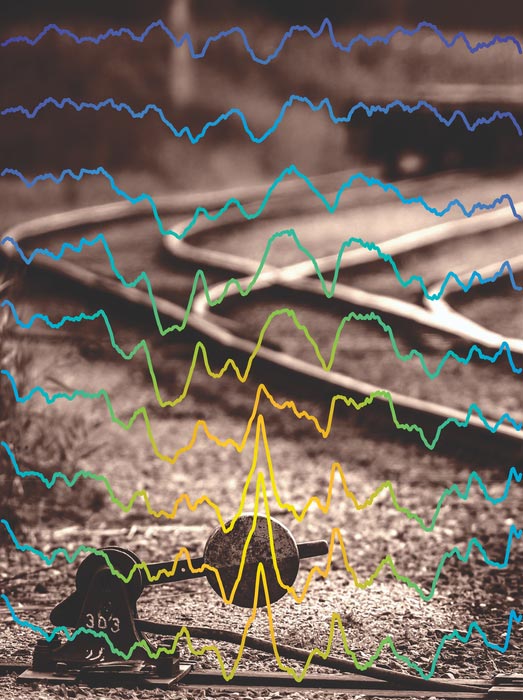Trains in the brain

This image superimposes hippocampal local field potentials on railway tracks controlled by a switch that is overlaid by a dentate spike colored yellow. Railway tracks provide different pathways to distinct destinations, like different hippocampal information processing modes can enable distinctive memory encoding and recollection information processing functions.
Credit: André Fenton, New York University
Scientists uncover switching system used in information processing and memory.
Findings Reveal Coordination Used to Avoid Neurological Clashes.
A team of scientists has uncovered a system in the brain used in the processing of information and in the storing of memories–akin to how railroad switches control a train’s destination. The findings offer new insights into how the brain functions.
“Researchers have sought to identify neural circuits that have specialized functions, but there are simply too many tasks the brain performs for each circuit to have its own purpose,” explains André Fenton, a professor of neural science at New York University and the senior author of the study, which appears in the journal Cell Reports. “Our results reveal how the same circuit takes on more than one function. The brain diverts ‘trains’ of neural activity from encoding our experiences to recalling them, showing that the same circuits have a role in both information processing and in memory.”
This newly discovered dynamic shows how the brain functions more efficiently than previously realized.
“When the same circuit performs more than one function, synergistic, creative, and economic interactions become possible,” Fenton adds.
To explore the role of brain circuits, the researchers examined the hippocampus–a brain structure long known to play a significant role in memory–in mice. They investigated how the mouse hippocampus switches from encoding the current location to recollecting a remote location. Here, mice navigated a surface and received a mild shock if they touched certain areas, prompting the encoding of information. When the mice subsequently returned to this surface, they avoided the area where they’d previously received the shock–evidence that memory influenced their movement.
The analysis of neural activity revealed a switching in the hippocampus. Specifically, the scientists found that a certain type of activity pattern in the population of neurons known as a dentate spike, which originates from the medial entorhinal cortex (DSM), served to coordinate changes in brain function.
“Railway switches control each train’s destination, whereas dentate spikes switch hippocampus information processing from encoding to recollection,” observes Fenton. “Like a railway switch diverts a train, this dentate spike event diverts thoughts from the present to the past.”
This research was supported by grants from the National Institutes of Health (R01NS105472 and R01MH099128).
Journal: Cell Reports
DOI 10.1016/j.celrep.2021.109497
Method of Research: Experimental study
Subject of Research: Animals
Article Title: Dentate spikes and external control of hippocampal function
Article Publication Date: 3-Aug-2021
Media Contact
James Devitt
james.devitt@nyu.edu
Office: United States
Cell: 914-522-3774
All latest news from the category: Studies and Analyses
innovations-report maintains a wealth of in-depth studies and analyses from a variety of subject areas including business and finance, medicine and pharmacology, ecology and the environment, energy, communications and media, transportation, work, family and leisure.
Newest articles

A universal framework for spatial biology
SpatialData is a freely accessible tool to unify and integrate data from different omics technologies accounting for spatial information, which can provide holistic insights into health and disease. Biological processes…

How complex biological processes arise
A $20 million grant from the U.S. National Science Foundation (NSF) will support the establishment and operation of the National Synthesis Center for Emergence in the Molecular and Cellular Sciences (NCEMS) at…

Airborne single-photon lidar system achieves high-resolution 3D imaging
Compact, low-power system opens doors for photon-efficient drone and satellite-based environmental monitoring and mapping. Researchers have developed a compact and lightweight single-photon airborne lidar system that can acquire high-resolution 3D…





















